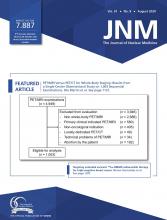Discussions with leaders: Ken Herrmann talks with Christoph Zindel, a member of the Managing Board of Siemens Healthineers, about global trends in medical imaging innovation and development.
Page 1088
COVID-19 and academic medicine: Johannes Czernin interviews Kelsey Martin, dean of the David Geffen School of Medicine at UCLA, about the impact of the pandemic on major medical schools and their students, faculty, and staff.
Page 1091
PRRT during COVID-19: Bodei and colleagues discuss factors for COVID-19 severity associated with peptide-receptor radionuclide therapy, focusing on the question of whether lymphopenia increases risk of infection-related morbidity.
Page 1094
Overcoming the COVID-19 crisis: LoGiudice and colleagues provide an overview of economic and other effects of the pandemic and describe a framework for identifying salient trends to assess consequences to health-care systems and support forward-looking strategies.
Page 1096
Workforce impact of COVID-19: Johannes Czernin addresses the need for government support for the health-care economy during the pandemic to ensure that hospitals remain solvent, job loss is slowed, and high-quality care is guaranteed.
Page 1104
Amyloid and tau PET for drug testing: Barthel and colleagues provide a critical appraisal of studies using longitudinal PET SUV ratios to determine pathologic amyloid and tau burden at baseline and after treatment in Alzheimer and related diseases.
Page 1105
PET and neuroinflammation: Jain and colleagues review the clinical potential of available and emerging PET biomarkers of innate and adaptive immune responses and point to future directions for the field.
Page 1107
Molecular image–guided surgery: Mondal and colleagues highlight the current state of molecular imaging and sensing technologies available for surgical guidance, including nuclear, optical, and multimodal approaches.
Page 1113
Clinical positron lymphography: Mueller and colleagues describe detection of tumor-positive lymph nodes in uterine/cervical cancer using 18F-FDG injected interstitially on the day of surgery, with dynamic PET/CT visualization of rapid transport to sentinel lymph nodes.
Page 1123
PET/MRI versus PET/CT in oncology: Martin and colleagues investigate differences between PET/MRI and PET/CT lesion detection and classification as well as radiation exposure in oncologic whole-body examinations.
Page 1131
Checkpoint imaging in oncology: Lütje and colleagues offer an overview of current developments in checkpoint-specific molecular imaging as a tool for patient selection and response evaluation.
Page 1137
68Ga-PSMA-HBED-CC repeatability: Pollard and colleagues determine the repeatability of 68Ga–prostate-specific membrane antigen–HBED-CC PET in a test–retest trial in individuals with metastatic prostate adenocarcinoma, with implications for therapy monitoring.
Page 1145
PSMA PET indications: Sonni and colleagues look at the impact of 68Ga-PSMA-11 PET/CT on initial and subsequent management decisions in prostate cancer patients referred for various indications, excluding biochemical recurrence and presurgical staging.
Page 1153
Dialysis during 131I therapy: Vermandel and colleagues detail experience with radioiodine treatment of thyroid cancer in chronic renal failure patients who require hemodialysis and report on serial dosimetry during therapy.
Page 1161
68Ga-FAPI-46 dosimetry: Meyer and colleagues present a PET biodistribution and radiation dosimetry study of this improved serine protease fibroblast activation protein inhibitor in cancer patients.
Page 1171
Accuracy of voxel-based dosimetry: Tran-Gia and colleagues describe SPECT/CT-based voxel-level dosimetry of a 3D-printed 2-compartment kidney phantom, resulting absorbed dose distributions, and the utility of a partial-volume correction tool.
Page 1178
Targeted radionuclide therapy for TNBC: Hernandez and colleagues demonstrate a promising preclinical strategy using a tumor-targeting alkylphosphocholine for targeted radionuclide therapy of triple-negative breast cancer.
Page 1187
Brain PET in CDCS: Cistaro and colleagues use 18F-FDG PET/CT to analyze metabolism in individuals with different clinical presentations of cri du chat syndrome and identify possible brain metabolic phenotypes.
Page 1195
TSPO PET imaging in tobacco smokers: Hillmer and colleagues compare brain 18-kDa translocator protein levels in 20 tobacco smokers and 20 nonsmokers using a fully quantitative modeling approach.
Page 1200
Pretargeted immuno-PET in breast cancer: Rousseau and colleagues assess the imaging performance of a novel pretargeting immunologic PET method in patients with human epidermal growth factor receptor 2–negative, carcinoembryonic antigen–positive metastatic breast cancer.
Page 1205
Radioligands for NR2B subunit imaging: Cai and colleagues report on synthesis of 11C-NR2B-SMe and its enantiomers as candidates for preclinical PET imaging of the NR2B subunit within the N-methyl-d-aspartate receptor.
Page 1212
AUC for PET MPI: Schindler and experts from 10 major professional organizations report on consensus recommendations for appropriate use criteria for myocardial perfusion imaging and myocardial blood flow assessment with PET.
Page 1221
- © 2020 by the Society of Nuclear Medicine and Molecular Imaging.







